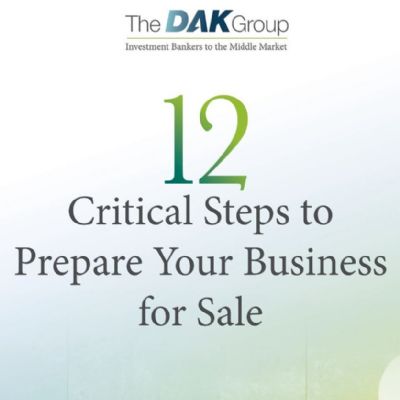So, what does preparation look like? Ahead of any potential
transaction, begin by understanding the variety of buyer options.
- Strategic buyers may place a premium on a company’s technology and customer base, while private-equity (PE) firms might be more interested in consolidation opportunities. Company owners must decide on the outcome they’re looking for in order to make the decisions that will make the business attractive to the kind of buyer being sought. A strategic buyer could be another metal-fabrication company looking to expand its reach or acquire new locations; cultural fit and compatibility of operations are crucial considerations.
- PE firms likely are interested in the potential
for consolidation. While they might offer a higher price, it's unlikely to be
all cash, and they often require the seller to retain some ownership and stay
involved for several years.
- Internal buyer: A business owner might prefer to sell the company to someone within the firm—a manager or key employee, for example. While such a smooth handover to a trusted individual seems appealing, challenges often arise around financing. If the internal buyer lacks sufficient funds to cover the full purchase price and requires a significant amount of financing, it can keep the seller tied to the success of the business and hinder his ability to retire or move on. Even worse, if financing limitations aren't addressed upfront, deals can fall apart, causing disappointment and damaging the relationship between seller and buyer.
Consider Modernization and Automation
Many potential buyers prioritize businesses that have
invested in newer automation technologies, such as fiber laser cutting machines
and automated bending equipment. However, fabricators should invest in new
technology and in training their workforce, to ensure operations are running
smoothly, well in advance of gauging potential buyer interest.
Also, check your financial readiness. Buyers often rely on bank financing to complete acquisitions. Having clean and well-organized financial statements can significantly improve a company’s chances of a successful sale. It can be helpful to present financials that meet bank requirements while establishing robust internal controls and recordkeeping. This transparency showcases a firm’s health and fuels a smooth financing process for the acquisition.
Preparing for Expansion
In some cases, fabricators want to grow the business and reach more
customers, perhaps to ensure the company is large enough to attract the right
kind of buyer. The current fragmented nature of the metal-fabrication industry presents
a unique growth opportunity for companies looking to expand their reach and
capabilities through strategic mergers and acquisitions (M&A). Again, planning ahead is your friend. Not all
acquisitions are created equal. Selecting the right target company is critical
for maximizing the benefits of a merger or acquisition.
Here's the approach:
- Look for complementary
capabilities. Don't just look for bigger; look for better. Identify
targets that possess capabilities that complement your existing offerings.
This could involve specialized skills that broaden your service portfolio,
geographic reach that expands your potential customer base, or
technological expertise to streamline production and enhance efficiency.
- Assess customer diversification.
Avoid putting all of your eggs in one basket. Target companies with
customer bases that differ from yours to mitigate risk in the event of a
downturn in a key customer market, and open doors for cross-selling.
- Focus
on financial feasibility. Acquisitions require significant financial investment. Focus on financial
due diligence, consider different funding strategies, and don't forget the integration
costs after the acquisition to ensure a smooth and successful transaction that
fuels your company's growth.
Beyond the Financials
Successful
integration also requires looking beyond the price tag. Among key nonfinancial
factors that deserve careful evaluation:
- Management-team
strength: Inheriting a skilled and experienced management team can be a
significant advantage for a buyer. For the best results, assess the
expertise of the target company's leadership, its track record and
strategic vision.
- Cultural
fit: Company culture significantly impacts success. Consider shared values,
as well as leadership and communication styles. Develop a plan to address
potential cultural clashes and retain valuable employees.
- Business
compatibility: A successful acquisition hinges on the strategic fit
between buyer and seller. Evaluate product/service overlap, customer-base
compatibility, operational alignment and potential integration challenges.
An Advisor’s Role
An advisor with experience in the metal fabrication industry
can help navigate the complexities of mergers, acquisitions and business sales.
Among the core tasks advisors take on:
- Company valuation
- Buyer selection
- Vetting potential buyers
- Deal structuring
- Financial and legal guidance. MF
Randy Rua has orchestrated hundreds of successful business merger and
acquisition transactions. He is the President of NuVescor, a trusted advisor
for manufacturing business owners navigating the M&A process.
Technologies: Management
 Randy Rua
Randy Rua For many metal fabricators, the market is booming; consolidation
presents a unique opportunity for small and medium-sized businesses to
capitalize. Whether seeking to maximize return through a sale, or expand reach
through acquisitions, fabricators should review this list of key steps toward
navigating this dynamic landscape.
For many metal fabricators, the market is booming; consolidation
presents a unique opportunity for small and medium-sized businesses to
capitalize. Whether seeking to maximize return through a sale, or expand reach
through acquisitions, fabricators should review this list of key steps toward
navigating this dynamic landscape.






